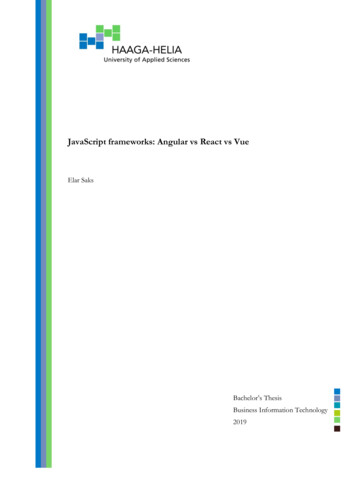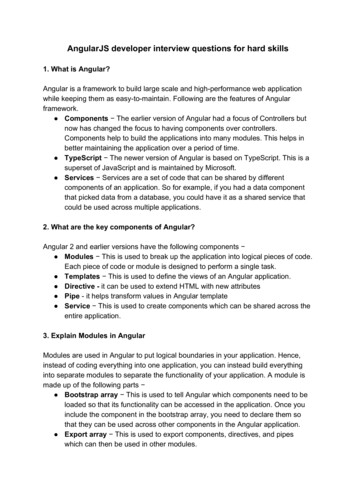
Transcription
Migrating fromAngularJS to AngularAngularJS is the name for all v1.x versionsAngular is the name for the angular (v2.x, v4.x, v5.x, v6.x, v7.x) of today and tomorrow1
2Table of ContentsFive compelling reasons to migrate to a higher version of Angular JS. 3An Illustrative Case Study . 5Our Client. 5Problem Statement . 5Approach: Big Bang . 5Going Big Bang . 6AngularJS to Angular Migration
3Five compelling reasons to migrate to a higher version of Angular JSIntroduced in the year 2009, the advent and growth of Angular JS has been nothing short ofspectacular. It swiftly evolved into a large open source library for web applications, and itsexpansiveness coupled with its popularity and the growth of the Javascript ecosystem wereinstrumental in Google acquiring Angular JS. However, times are changing. Google had announced inearly 2018 that Angular JS would have its Long Term Support (LTS) till June 30th, 2021, after which itwould not maintain the library. As a consequence, the need and necessity for migrating to Angular,the higher version of Angular JS has become stronger.Here are five compelling reasons for organisations using Angular JS to migrate to Angular:Maintainability of code – Over a period of time, when the application code size(in Angular JS) gets bigger, bad patterns like tight coupling, duplicate code, longmethods, large classes, and more bugs are detected in the code. To solve theseissues, refactoring the code is required. However, instead of Code Refactoring inthe same version the code can be rewritten in Angular 7: a seamless migration to ahigher version addressing both code refactoring and migration in one swift move.Performance – Typically, as the number of lines in a code increase, the amount ofdata being handled in the application increases, and consequently, theperformance of the application gradually degrades. Angular has reduced thebundled file size by 60% compared to Angular JS. This translates to reduction incodes being generated and hence an accelerated application performance whencompared to Angular JS.Tools – One inconvenience which developers have overlooked because of thegazillion advantages provided by Angular JS is the use of external tools for testingand debugging. In contrast, Angular comes with the advantage of having inbuiltapplication testing and debugging, along with command line tools. Additionally,the CLI takes care of Jasmine and Karma configuration. Developers can also unittest an Angular app with other testing libraries and test runners. Each library andrunner has its own distinctive installation procedures, configuration, and syntax.Another attractive facet of Angular is that the Continuous integration (CI) serversallow the developers to set up their project repository so that their tests run onevery commit and pull request.AngularJS to Angular Migration
4Language – JavaScript does not provide Type Safety which enables a developer tostore a value in the variable. However Angular uses Typescript for Type Safety,where the developer can switch on the Type Safety to store values based on thevariable type. Typescript also supports type inference using TLS (TypescriptLanguage Service). In a nutshell, Typescript can be looked as a super set ofJavascript which augments the benefits that Javascript provides, especially in amulti-developer, large project scenario.Better Architecture (Think reusability) – Angular JS’s two-way data bindingconcept results in delays and bottlenecks for development projects. In contrast,Angular uses an architecture based on a hierarchy of components and services,which helps in reusing elements, thereby saving time and ensuring faster projectdeliveries.AngularJS to Angular Migration
5An Illustrative Case StudyOur ClientUS based Emergency Dispatch ServiceOver a period of time, one of our client applications grew bigger in size and its performance sloweddown. The performance was not optimal when we included more new features to the application.Problem StatementThe challenges and the problem statement we faced while working with AngularJS are: Maintainability of code and code refactoring became difficult as there were a lot of dead codesand also it took lot of time to fixbugs. There is no enforced code structure in AngularJS. Some of plugins which was in AngularJS are in maintenance mode, there have been no update forlong time. The repository was not updated for long time. Active development was happening only in theangular version of plugin. Large amount of data and data handling became cumbersome in AngularJS.We had to keep building upon the existing AngularJS application for a few months and work on bugfixes in parallel. The application’s end users expected new features as well as performanceimprovements.Client intended to migrate to the latest version of Angular at the earliest and our team was quiteexcited with the client’s perspective. Working with the most cutting-edge tool set is always anopportunity to grow as professionals and to dive into all the latest solutions.Approach: Big BangWe decided on refactoring the application with latest version of Angular using the big bang approach.To reconcile further development with fixing bugs, we decided that half of the team would work onnew features and the other half would be re-writing the old components in Angular.AngularJS to Angular Migration
6Going Big Bang The first thing we paid attention to was the architecture, as the main demand of our client was theopportunity to customize the widget so that a customer sees only his/her personalized themesand settings, whereas all the customer styles are kept on repos. After architecture, we thought about routes (URLs), that is how URLs change while one is surfingthe website. We did have all the plugins and UI ready, so we were able to migrate over a short period of time. Due to type-checking feature, we were able to identify errors at an early stage while writing code. We made use of unit testing capabilities in Angular CLI to improve the quality in code. Data interaction and performance was better compared to that of AngularJS. Build is more simplified.AngularJS to Angular Migration
7About OptiSol Business SolutionsOptiSol is proficient service provider for Social, Mobile, Analytics and Cloud solutions and focusing onbuilding innovation for our clients in more than 24 countries. With 200 smart employees, we act as thereliable outsourcing services partner, providing optimized business solutions with delivery excellence toboth enterprises of all sizes, worldwide. Through our services on Consulting, Solutions, Mobility, AI/ML,Cloud Computing and Big Data, we assist our clients to transform and thrive in a changing world.We are equipped with creative engagement models and operations framework that suits outsourcingneeds from all gamut of customer’s startup, Independent Software Vendor (ISV), small or mid-sizecompanies and Enterprises. It has been serving its customer base across breadth and width of technologyoutsourcing needs that spans across.AngularJS to Angular Migration
However Angular uses Typescript for Type Safety, where the developer can switch on the Type Safety to store values based on the variable type. Typescript also supports type inference using TLS (Typescript Language Service). . To reconcile further development with fixing bugs, we decided that half of the team would work on .











